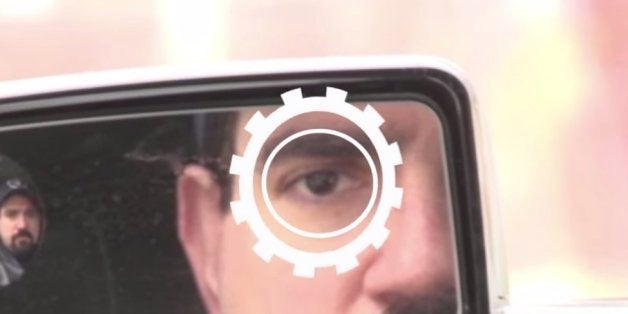
Technology to identify people by matching the irises of their eyes against a database has existed for years, but a new invention could now allow us to do the same thing from much farther away. As Robinson Meyer reported in The Atlantic, long range iris-scanning is here.
In the short video below, professor Marios Savvides demonstrates a prototype device he and his students developed at the CyLab in Carnegie Mellon's School of Engineering.
In 2009, the CyLab Biometric Lab received a 1.5 million dollar grant from the Department of Defense to work on long-distance iris recognition. This prototype is the result.
The American military has been using handheld iris recognition devices in Iraq and Afghanistan since 2004, compiling a database of millions of iris scans. Consumers can expect iris scanners to be part of mobile devices and buildings in the near future. Apple might use iris scanning in future generations of its iPhones and iPads, for instance, building on the fingerprint authentication it already has in its newest devices. Eventually, law enforcement and counterterrorism agencies could use long-distance iris recognition to match the "eye prints" of people moving across international borders or transit points to persons of interest.
"This project started when I was reading about how soldiers were using devices out in the field, using devices and trying to match just 5 inches away from harm's way," said Savvides. "I thought that if could we build a way that can protect our soldiers so that they can stand further away, they'd be safer. Capturing and recognizing from a distance could mean the difference from a soldier having to walk up to a person and step on an IED or walk up to a potential terrorist who may be strapped in explosives. Having the ability to detect threat from a distance can save lives."
Savvides believes that long-distance iris scanners could be used to prevent child trafficking, protect soldiers in the field and enable police to catch criminals who would otherwise escape justice. But unlike portable units or devices mounted on buildings, long-distance iris scans could be obtained without a subject's knowledge or consent, which creates new horizons for covert use and abuse. If the patented invention is further developed and adopted on a broader scale, it will have the ability to shift the balance between privacy and obscurity.
Databases of biometric identifiers are already being built up domestically. Last year, the National Journal reported that the FBI projected its database of biometric identifiers (including iris scans) could catalog up to 52 million photos of faces by 2015.
Savvides, whose background is in software, not optical engineering, worked with his students to develop a system that can capture an iris from 6 to 12 yards away. Desktop units can capture images of an iris 18 inches away, while airport scanners can capture images 1 to 2 yards away. CyLab's key innovation is the long-distance ability, combined with pattern recognition software. For the current prototype to work, a person's eye has to stay stationary for 3 seconds -- though a reflection in a mirror is sufficient, as you can see in the video embedded above. For its next version, CyLab is working on capturing images of eyes in motion.
As the technology matures and infrastructure barriers to its use fall, the primary issue is likely to be public opinion and the objections of civil liberties groups. The American Civil Liberties Union has warned of the privacy risks of eye tracking, including enabling governments or companies to make guesses about a person's sexuality, detect whether they have a mental illness or even see if they've been drinking or using drugs.
If long-distance iris recognition leaves the prototype stage, it will also become one of several surveillance tools that democratic governments must apply export controls to, in order to prevent authoritarian governments with poor human rights records from obtaining the technology. The same iris recognition software that could enable law enforcement to stop a known terrorist from crossing the Mexico border or a prevent a serial killer from skipping town at a train station could be applied in other contexts to identifying protestors and journalists for secret police to track down.
Savvides expressed frustration with the way that Hollywood has affected public views and understanding of biometrics, pointing to dystopian depictions of them in films like "Minority Report."
"What we don't see is the fact that every second there's a crime somewhere, there's CCTV footage, and law enforcement has no idea who it is," he said. "The CSI effect is not real."
Even if the CyLab's iris detection rig is a prototype, Savvides said that he's received strong interest from law enforcement agencies and at least one nonprofit, Seraphim Global, which provides technical support to human rights organizations and humanitarian causes. Savvidas also holds a patent for continuous authentication -- where an iris scanner could be used to ensure that only verified personnel are looking at health or legal records on a given screen.
Savvidas also noted that improved iris verification systems could be useful in a public health context, if they enable people to avoid touching screens that spread diseases. They could also help solve the issue of bad passwords.
Many of his peers in the biometrics industry agree with him. In a 2014 white paper from the International Biometrics & Identification Association, the group argues that facial recognition does not increase the use of surveillance or make "face stalking" more practical.
But critics also point to the security risk that huge databases of biometric markers could pose. When data breaches have led to stolen credit card numbers, consumers can change them. If digital biometric identifiers are stolen by hackers, it's difficult to change a fingerprint or eyeball.
When we talked through some of the potential issues, Savvides acknowledged the concerns and highlighted some potential technical solutions, like "cancellable biometrics" that distort the actual fingerprint or iris scan when it's stored. His lab has worked on techniques for cancelable biometric filters for face recognition.
"There are ways that you don't have to send your actual metrics somewhere," he said. "Even if it's stolen, how can someone use it? You would have to go to great lengths to spoof it, and the systems are getting better all the time, detecting if they are looking at a picture or a face."
While the potential for misuse exists, Savvides holds that positive applications of iris recognition scanning will be used for the public good, not against citizens. In his view, the Boston Marathon bombing was one example where law enforcement didn't have the tools it needed to catch a perpetrator. This kind of system might have helped.
"Guns can be used in a good way or a bad way," he said. "Anything can be misused. I condemn the use of technology being used in a bad way. I see a great demand for this tech to be used to save lives. I really hate that it's painted negatively. You could save so many people's lives, from criminals to abducted people."
